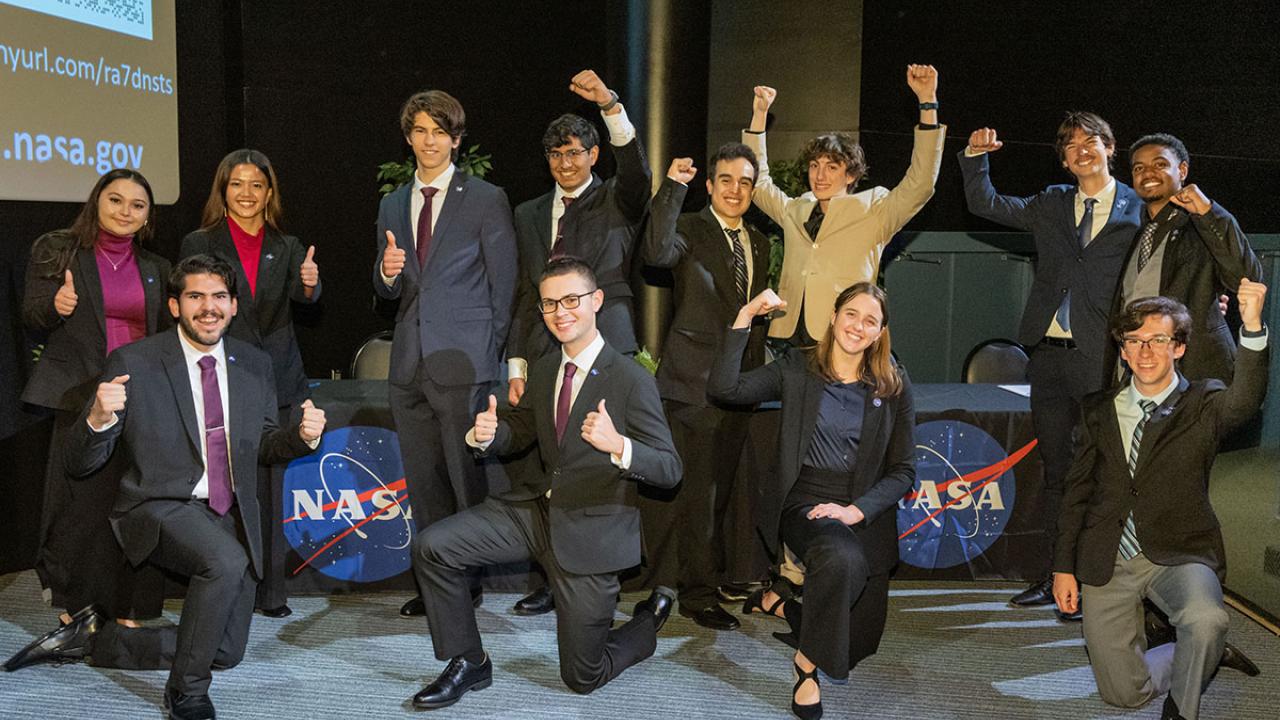
Q&A with Aggie Space Initiative
Last month, a team of undergraduate engineering students from the University of California, Davis, pitched at the NASA Minority University Research and Education Project Innovation and Tech Transfer Idea Competition, or MITTIC. The team took second place and a prize of $10,000.
Aimed at fostering innovation and creativity, MITTIC invites students from all academic backgrounds to apply their knowledge and skills in a unique way — by using NASA's intellectual property to solve real-world problems.
Aggie Space Initiative: A Students for the Exploration and Development of Space chapter at UC Davis, or ASI SEDS, pitched Regena-Field, a compressive wrist brace that uses biomagnetic research from NASA to speed up tissue repair, optimize recovery time and promote blood flow.
The team is made up of students Yemikael Dawit, Liam Swenson, Haelie Tweet, Orfeas Magoulas, Angel Magana and Sean DeHaesleer, mentored by their advisor Rich Whittle, assistant professor in the Department of Mechanical and Aerospace Engineering.
During the competition, the team had the opportunity to speak with a NASA astronaut and tour the Johnson Space Center facilities such as the Neutral Buoyancy Lab, Orion Training Facility and ISS Mission Control.
Read about the competition in their own words:
How did it feel to win $10,000 at a NASA competition?
Liam Swenson: Securing $10,000 at a NASA competition was a surreal experience. It marked the culmination of months of hard work and dedication, and although the process was long, hearing Regena-Field be announced as one of the two winning teams was well worth it. Winning the grant also marked a huge step towards making Regena-Field a reality, and knowing there's much more to come is incredibly exciting. I'm so proud to have been a part of this team and to have won among all the incredible pitches that our peers had made.
How did you come up with the concept for your pitch?
Sean DeHaesleer: We started with just the six of us scrolling through NASA's list of patents in the Teaching and Learning Complex on campus. We brainstormed problems that exist in the world that the patents could be a potential solution to without actually thinking about the technical details of how the solution would work (which wasn't easy for a bunch of engineers) and made a list of 6-7 patents.
From there, we chose the three ideas with the most interest and broke into smaller groups based on the ideas we each wanted to pursue. After a couple weeks, we had enough information to narrow our options down to the Bio-magnetic Device patent that Regena-Field would be based on.
What were some of the key challenges you faced during the competition?
Haelie Tweet: At MITTIC, the days were full of tours through Johnson Space Center and insightful talks with alumni, an astronaut, and industry experts. This left little time in the evenings to prepare for our speech. We also had some major anxiety the night before and the morning of the pitch. Ultimately
What do you think set your pitch apart from the other competitors?
Orfeas Magoulas: From the very beginning, we worked incredibly hard to fully understand who we were pitching to, how we could pitch it best and the challenging questions they might throw at us along the way. We ensured that all of us understood every aspect of our product, to the extent where either of us could pitch anyone's part.
Although the actual pitch was nerve-wracking, our preparation gave us unfaltering confidence allowing us to flawlessly execute it, impressing all the judges and confidently answering all the questions they threw at us!
How well do you work together as a team?
Angel Magana: Each team member had an important role in our success. The skills of everyone in our group synergized well, allowing us to work on several tasks simultaneously as we prepared our proposal and, later, our pitch to NASA. Every week, we would distribute work that needed to be done, which ensured we were always contributing towards our goals as a team. This work ethic allowed us to finish our initial proposal despite the tight deadline, which passed the first phase of the competition and won us a trip to the Johnson Space Center, becoming one of the top 11 teams from across the country.
Overall, being part of a team felt amazing and the contributions of each member made the achievement of being second place in the country possible.
What are your plans moving forward as a team - what's next?
Yemikael Dawit: Moving forward, there are two key initiatives underway at Regena-Field.
Firstly, NASA MITTIC Headquarters will provide us with invaluable feedback from the judges regarding our pitch and strategic advice on navigating the path forward.
In parallel, we've laid the groundwork for our application's architecture and embarked on thorough research into clinical trials, potential markets, insurance considerations for pricing our product and the process of getting permission to use NASA's intellectual property in our idea.
As we prepare to propel Regena-Field towards its next phase of growth and impact, we are also planning for next year's NASA MITTIC and finding a way to get even more people within UC Davis involved to have an opportunity to travel to the Johnson Space Center and compete again!
Follow Aggie Space Initiative (@aggiespaceinitiative) on Instagram to stay up to date on what the team does next.
